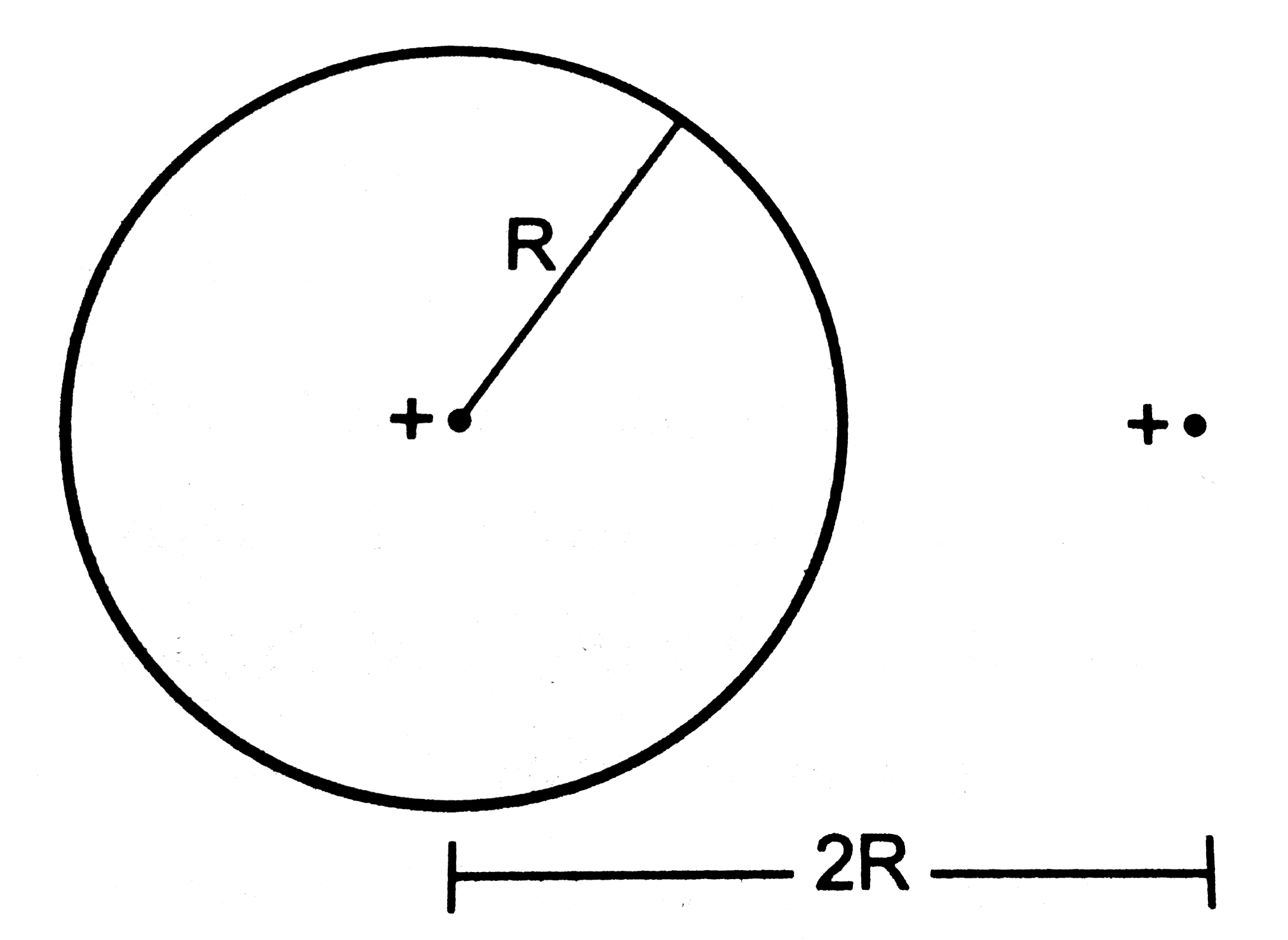A charged shell of radius R carries a total charge Q. Given as the flux of electric field through a closed cylindrical surface of height h, radius r & with its centre same as that of the shell. Here centre of cylinder is a point on the axis of the cylinder which is equidistant from its top & bottom surfaces. which of the followintg are correct.
If and then
If then
If then
If and then
The correct Answer is:B, C, D
To solve the problem step by step, we will analyze the situation based on the provided information about the charged shell and the cylindrical surface.
1. Understanding the Problem:
- We have a charged shell of radius R carrying a total charge Q.
- We need to find the electric flux ϕ through a closed cylindrical surface of height h and radius r centered on the axis of the shell.
2. Using Gauss's Law:
- According to Gauss's Law, the electric flux ϕ through a closed surface is given by:
ϕ=Qenclosedϵ0
- Here, Qenclosed is the charge enclosed by the Gaussian surface, and ϵ0 is the permittivity of free space.
3. Case Analysis:
- We will analyze different cases based on the height h of the cylinder and its radius r.
Case A: h>2R and r=4R5
- Charge Enclosed:
- The cylinder extends beyond the shell. The charge enclosed can be calculated using the angle subtended by the cylinder at the center of the shell.
- Using geometry, we find the angle θ corresponding to r=4R5 and calculate the enclosed charge:
Qenclosed=2⋅(1−cos(θ))⋅Q4π
- For r=4R5, θ can be calculated as tan−1(4R/5R).
- Flux Calculation:
- The flux through the cylindrical surface can be expressed as:
ϕ=Qenclosedϵ0
Case B: h>2R and r=3R5
- Charge Enclosed:
- Similar analysis as in Case A, but now with r=3R5.
- Calculate the angle θ and the enclosed charge:
Qenclosed=2⋅(1−cos(θ))⋅Q4π
- Flux Calculation:
- Again, use Gauss's Law to find the flux:
ϕ=Qenclosedϵ0
Case C: h>2R and r>R
- Charge Enclosed:
- The entire charge Q is enclosed since the cylinder is outside the shell.
- Flux Calculation:
- The flux is:
ϕ=Qϵ0
Case D: h<4R and r=3R5
- Charge Enclosed:
- If the cylinder is entirely within the shell, the enclosed charge is zero.
- Flux Calculation:
- The flux is:
ϕ=0
Summary of Results:
- For Case A, the flux is 2Q5ϵ0 (not correct).
- For Case B, the flux is Q5ϵ0 (correct).
- For Case C, the flux is Qϵ0 (correct).
- For Case D, the flux is 0 (correct).
Correct Statements:
- The correct options are B, C, and D.
- We have a charged shell of radius R carrying a total charge Q.
- We need to find the electric flux ϕ through a closed cylindrical surface of height h and radius r centered on the axis of the shell.
- According to Gauss's Law, the electric flux ϕ through a closed surface is given by:
ϕ=Qenclosedϵ0
- Here, Qenclosed is the charge enclosed by the Gaussian surface, and ϵ0 is the permittivity of free space.
- We will analyze different cases based on the height h of the cylinder and its radius r.
- The cylinder extends beyond the shell. The charge enclosed can be calculated using the angle subtended by the cylinder at the center of the shell.
- Using geometry, we find the angle θ corresponding to r=4R5 and calculate the enclosed charge:
Qenclosed=2⋅(1−cos(θ))⋅Q4π
- For r=4R5, θ can be calculated as tan−1(4R/5R).
- The flux through the cylindrical surface can be expressed as:
ϕ=Qenclosedϵ0
- Similar analysis as in Case A, but now with r=3R5.
- Calculate the angle θ and the enclosed charge:
Qenclosed=2⋅(1−cos(θ))⋅Q4π
- Again, use Gauss's Law to find the flux:
ϕ=Qenclosedϵ0
- The entire charge Q is enclosed since the cylinder is outside the shell.
- Flux Calculation:
- The flux is:
ϕ=Qϵ0
- If the cylinder is entirely within the shell, the enclosed charge is zero.
- Flux Calculation:
- The flux is:
ϕ=0
- For Case A, the flux is 2Q5ϵ0 (not correct).
- For Case B, the flux is Q5ϵ0 (correct).
- For Case C, the flux is Qϵ0 (correct).
- For Case D, the flux is 0 (correct).
- The correct options are B, C, and D.
Topper's Solved these Questions
- BOOK - VMC MODULES ENGLISHCHAPTER - ELECTROSTATICSEXERCISE - JEE MAIN65videos
ELECTROSTATICS
- BOOK - VMC MODULES ENGLISHCHAPTER - ELECTROMAGNETIC INDUCTION & ALTERNATIVE CURRENT EXERCISE - IMPECCABLE52videos
ELECTROMAGNETIC INDUCTION & ALTERNATIVE CURRENT
- BOOK - VMC MODULES ENGLISHCHAPTER - ENERGY & MOMENTUMEXERCISE - JEE ADVANCE (ARCHIVE) - TRUE/FALSE TYPE1videos
ENERGY & MOMENTUM
Similar Questions
A conducting shell of radius R carries charge–Q. A point charge +Q is placed at the centre of shell. The electric field E varies with distance r (from the centre of the shell) as :
View SolutionFind the fluz f the electric field through a spherical surface of radius R due to a charge of 10−7C at the centre and another equal charge at a point 2R away from the centre (figure ).
 View Solution
View SolutionA conducting shell of radius R carries charge −Q. A point charge +Q is placed at the centre. The electric field E varies with distance r (from the centre of the shell) as
View SolutionA charge q is placed at the centre of the open end of a cylindrical vessel . The flux of the electric field through the surface of the vessel is
 View Solution
View SolutionConsider a cylindrical surface of radius R and length l in a uniform electric field E. Compute the electric flux if the axis of the cylinder is parallel to the field direction.
View SolutionA non-conducting spherical shell of radius R surrounds a point charge q (q at center). The electric flux through a cap of the shell of half angle θ is:
View SolutionA non-conducting spherical shell of radius R surrounds a point charge q (q at center). The electric flux through a cap of the shell of half angle θ is:
View SolutionA conducting sphere of radius R is given a charge Q. The electric potential and the electric field at the centre of the sphere respectively are
View SolutionA conducting sphere of radius R is given a charge Q. The electric potential and the electric field at the centre of the sphere respectively are
View SolutionFind the flux of the electric field through a spherical surface of radius R due to a charge of 8.85×10−8C at the centre and another equal charge at a point 3R away from the centre (Given : ε0=8.85×10−12 units )
 View Solution
View Solution

